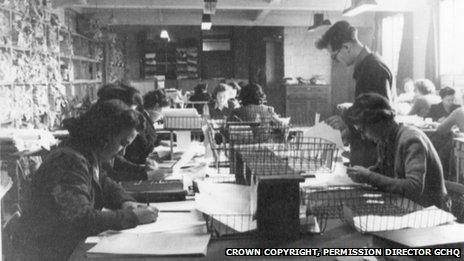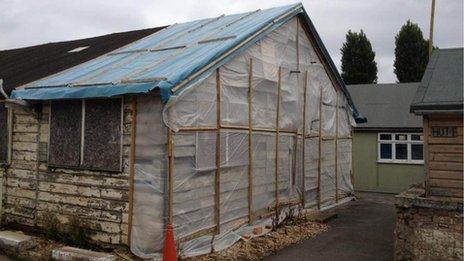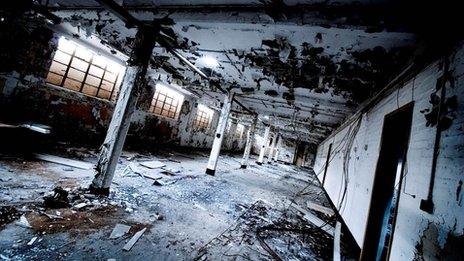Bletchley Park enigma code huts prepare for restoration
- Published
Bletchley Park's Iain Standen shows Gordon Corera inside Hut 3
During World War II, Huts 3 and 6 of Bletchley Park were home to some of the finest minds in the country, working around the clock to crack German codes.
Today, the only inhabitants you will find inside those buildings in Buckinghamshire are a pigeon and a rat - both deceased.
Hut 6 was at the centre of the actual breaking of the enigma code used by the German army and air force.
Hut 3 was then passed the decoded messages for translation, analysis and dispatch.
Left to rot
Seventy years ago, smoke would have hung in the air from the cigars and cigarettes smoked by the assorted workers and from the fires that were lit to keep the buildings warm.
Now there are drips from pipes falling into large holes in the floor.
Whilst other parts of Bletchley Park have been restored, many of the key buildings - like Huts 3 and 6 - have been left to ruin, but not for much longer as a major refurbishment project will get under way in the coming days.

How Hut 6, Bletchley Park, looked during its WWII code-breaking days...
While the grand, though not beautiful, main house is the most iconic image of Bletchley Park, the huts were where much of the real work took place. They were austere, functional buildings, built to purpose.
"They are our artefacts," says Iain Standen, the CEO of Bletchley, who showed me around. "They are what Bletchley is all about. We want to restore them back to their former glory."
Bletchley's role in breaking German codes was kept secret not just during the war but for decades after and only began to emerge in the 1970s.
There may have been good security reasons for this, but the consequences for the site were catastrophic.
Nothing was done to preserve the past and many of the huts, which had been thrown up in a hurry, filled with asbestos and never built to last, were allowed to rot away.
'Big challenge'
The refurbishment project is complex. Some of the huts need to be stripped of asbestos and reconstructed - just not too much.
"A real big challenge for us is that we don't take them back to looking too new," says Iain Standen. "They need to be looking slightly weathered at the corners."
The idea is to have visitors taken back to the 1940s and to understand the often austere environment in which the work was taking place.

....and how it looks today, before refurbishment
Block C is in the worst state. It was used to hold the card index for all the material Bletchley Park had gleaned and which could be useful for breaking codes.
A torch is needed to explore its darker recesses. Pigeons have taken over. One room, with a solitary green chair in the middle, looks more like something from a horror film.
And yet the ambition is that this block will become a new visitor's centre, the first experience new arrivals have of the park.
"It is our intention, when you step through the door here, you will be stepping back in time and you will be in the 1940s," explains Janie Price from Kennedy O'Callaghan, the architects involved.
D-Day deadline
The buildings are being restored thanks to a £7.4m Heritage Lottery Fund grant.
It is targeted to be completed by June 2014, to coincide with the 70th anniversary of the D-Day landings, which Bletchley aided through its part in deception operations to convince Germany the invasion would take place elsewhere.

There is work to do before the 2014 70th anniversary of the D-Day landings
"If Bletchley could do it on time then I've got to do it on time," says Steve Prowse who is project-managing the rebuild.
"Some of the Bletchley atmosphere rubs off. If they were able to do this sort of work in these sort of conditions, then there's no excuse why we can't make it work."